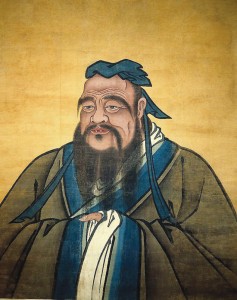| Confucianism: Form As Much As Content | |
|
By Hue Khai
Confucianism in Vietnam
http://www.vietnam-culture.com/articles-112-16/Confucianism.aspx
Confucianism’s originator, K’ung Fu Tzu (Latinised to Confucius), was an official in the Chinese court. During his lifetime (around 500 BC), China had broken into rival states fighting for supremacy. Confucius, comparing the turmoil of the life of the people with the formalised rituals of the court, set about creating a code to regulate social conduct, thereby enabling people to live in peace and harmony. He left the court and travelled the country, explaining his ideas.
The principles of Confucianism
At the heart of his teaching were two fundamental principles, the necessity of correct behaviour and the importance of loyalty and obedience. In each case, the message was reinforced by rites and ceremony. He made no mention of a spiritual dimension, but stressed the observance of traditional rituals. The status of Confucianism as a ‘religion’ in Vietnam is, therefore, questionable.
At that time, the philosophy was radically different. Status was to be acquired not by power and heroic actions, but by selflessness, respect for others and non-violent behaviour. It challenged the concept of lineal heredity by associating a person’s worth with learning, rather than birthright. Only intellect and erudition could give an individual a ‘Mandate from Heaven’ to be in a position of authority.
Confucian precepts
The ideas of Confucius took root in China, and developed further. Deference was central to the code of conduct: children were to obey their parents without question, wives their husbands, students their teachers and citizens their rulers. Education was the primary means of advancement.
Confucius’s ideas led to a rigidly stratified society. Children were taught their filial duties to their parents and the community to prepare them to assume their correct place in the social hierarchy and to behave accordingly. Those that succeeded in education would achieve higher rank. Those that surpassed their fellows would be able to enter the ranks of the Mandarins, a non-hereditary ruling class immediately under the Emperor.
Social stability at the expense of progress
The emphasis upon tradition and social order created stability and uniformity but, over time, diminished national and personal initiative. Progress and change slowed to a snail’s pace. Gradually Confucianism absorbed elements of Taoism, degenerating into an ideology in which the Emperor and Mandarins used their ‘Mandate from Heaven’ for their own purposes. Eventually, a stagnating China was easy prey for invaders from Europe, whose military technology had long outpaced that of the Chinese.
Confucianism in Vietnam
Confucianism was firmly implanted in Vietnam during the thousand years of its occupation by China and mirrored its development. As in China, an intellectual elite developed, and the principles of obedience and respect for education and authority were instilled throughout society, profoundly influencing the family structure and creating a tightly defined social hierarchy.
In Hanoi in 1070, the establishment of the Van Mieu (Temple of Literature), a temple of learning dedicated to Confucius, marked the emergence of Confucianism as a cult. Like China, it reached a peak during the 15th century – the ‘golden age’ of King Le Thanh Tong, then steadily decayed into decadence and corruption opening the door for the French invasion.
The influence of Confucianism in Vietnam
The profound impact of Confucianism remains strong in Vietnam. Social order is defined by its principles, and the rituals or deference and obedience are still observed. Unlike the West, teachers and education are held in high esteem, children defer to their parents, even in middle age and beyond, and most wives still follow the wishes of their husbands without question.
However, the value of Confucianism as a moderating influence upon social behaviour is being rapidly superseded by the need for flexibility and openness in a developing society.
RELATED ARTICLES






